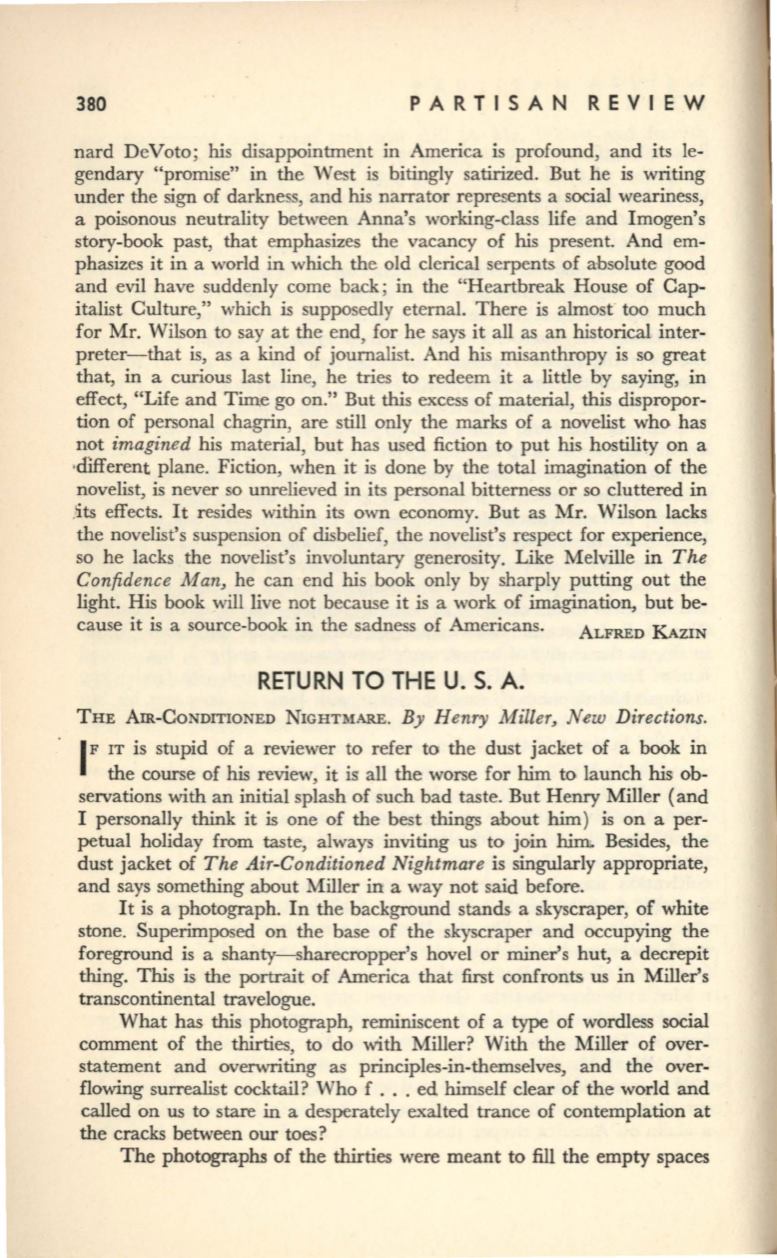
380
PARTISAN REVIEW
nard DeVoto; his disappointment in America is profound, and its le–
gendary "promise" in the West is bitingly satirized. But he is writing
under the sign of darkness, and his narrator represents a social weariness,
a poisonous neutrality between Anna's working-class life and Imogen's
story-book past, that emphasizes the vacancy of his present. And em–
phasizes it in a world in which the old clerical serpents of absolute good
and evil have suddenly come back; in the "Heartbreak House of Cap–
italist Culture," which
is
supposedly eternal. There is almost too much
for Mr. Wilson to say at the end, for he says it all as an historical inter–
preter-that is, as a kind of journalist. And his misanthropy is so great
that, in a curious last line, he tries to redeem it a little by saying, in
effect, "Life and Time go on." But this excess of material, this dispropor–
tion of personal chagrin, are still only the marks of a novelist who has
not
imagined
his material, but has used fiction to put his hostility on a
·different plane. Fiction, when it is done by the total imagination of the
novelist, is never so unrelieved in its personal bitterness or so cluttered in
.~ts
effects. It resides within its own economy. But as Mr. Wilson lacks
the novelist's suspension of disbelief, the novelist's respect for experience,
so he lacks the novelist's involuntary generosity. Like Melville in
The
Confidence Man,
he can end his book only by sharply putting out the
light. His book will live not because it is a work of imagination, but be–
cause it is a source-book in the sadness of Americans.
ALFRED KAZIN
RETURN TO THE U. S. A.
THE
Am-CoNDITIONED
NIGHTMARE.
By Henry Miller, New Directions.
I
F IT
is stupid of a reviewer to refer to the dust jacket of a book in
the course of his review, it is all the worse for him to launch his ob–
servations with an initial splash of such bad taste. But Henry Miller (and
I personally think it is one of the best things a:hout him) is on a per–
petual holiday from taste, always inviting us to join
him.
Besides, the
dust jacket of
The Air-Conditioned Nightmare
is singularly appropriate,
and says something about Miller in a way not said before.
It is a photograph. In the background stands a skyscraper, of white
stone. Superimposed on the base of the skyscraper and occupying the
foreground is a shanty-sharecropper's hovel or miner's hut, a decrepit
thing. This is the portrait of America that first confronts us in Miller's
transcontinental travelogue.
What has this photograph, reminiscent of a
type
of wordless social
comment of the thirties, to do with Miller? With the Miller of over–
statement and overwriting as principles-in-themselves, and the over–
flowing surrealist cocktail? Who f ... ed himself clear of the world and
called on us to stare
in
a desperately exalted trance of contemplation at
the cracks between our toes?
The photographs of the thirties were meant to fill the empty spaces


